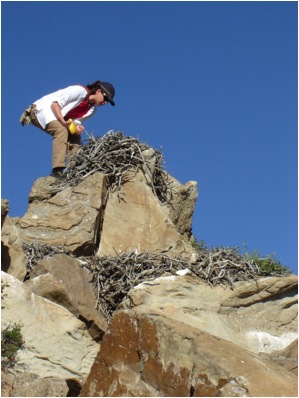Protection Plans: Bird conservation & project management
 Ecology and wildlife conservation is an issue with almost any construction project, and renewable energy projects are no exception. This is particularly true of wind energy farms, which are often located in remote, ecology rich areas. Bird management and conservation is a necessary consideration for any wind energy developer. Nesting birds on turbine grounds or to-be turbine grounds are of particular concern, often creating project delays before construction even begins.
Ecology and wildlife conservation is an issue with almost any construction project, and renewable energy projects are no exception. This is particularly true of wind energy farms, which are often located in remote, ecology rich areas. Bird management and conservation is a necessary consideration for any wind energy developer. Nesting birds on turbine grounds or to-be turbine grounds are of particular concern, often creating project delays before construction even begins.
Fortunately, new approaches are helping renewable energy project proponents to streamline agency consultation, and reduce the risk of project delays resulting from nesting birds at construction sites. Since 2005, the US Fish and Wildlife Service (USFWS) has recommended that site planners voluntarily develop Avian Protection Plans to reduce an electrical transmission project’s impact on birds—particularly bald and golden eagles—during building and operation.
Although originally specific to transmission projects, USFWS now recommends Avian Protection Plans be developed for any large-scale energy project, including for wind and solar power farms. These plans serve to outline design standards, training programs, permit compliance, as well as reporting and monitoring programs that collectively reduce the risk of avian mortality during site construction and operation.
Avian Protection Plans also act as a tangible way to document compliance with federal and state wildlife regulations, including the Bald and Golden Eagle Protection Act, and the Migratory Bird Treaty Act (MBTA).
Avian safety
Recently, the USFWS and other wildlife agencies have recommended the use of Nesting Bird Management Plans (NBMPs). These plans, either appended to an Avian Protection Plan or implemented as stand-alone documents, detail protective measures that will be implemented to protect special status and non-special status bird species during the construction and operation of a project.
Nesting birds have been highlighted as a resource of increased concern on many large transmission, wind, and solar projects. Increasingly, project proponents and compliance agencies are spending a large amount of effort and resources on nesting bird protections during project implementation. This situation has arisen because no regulatory mechanism currently exists to authorize incidental take of a common bird species the way an Incidental Take Permit allows for a listed species under the federal and California Endangered Species Acts. Take permits often include a list of avoidance and mitigation measures set by the signatory agency that project proponents must implement during construction. In the absence of such a permit, NBMPs outline how avoidance and mitigation measures will be implemented to protect birds during construction.
To help simplify the process, the California Public Utilities Commission (CPUC), federal and state resource agencies—such as the California Department of Fish and Game (CDFG), USFWS, Bureau of Land Management (BLM), US Forest Service (USFS)—and several California utilities have initiated discussions concerning the development of NBMPs in a standardized, consistent fashion.
An effective NBMP should be developed in consultation with resource agencies responsible for project oversight (such as, USFWS, CDFG, BLM, USFS), and should include several key components. A focused species list allows the environmental compliance team to develop measures relevant to the species most likely to occur within a project area. Spatial buffers—a common measure used in NBMPs for many recent projects—should be tailored to the sensitivities and life histories of these birds. In addition, the NBMP should include detailed methodologies for surveying, monitoring, and reporting during construction.
Action-plan benefits
The development of a Nesting Bird Management Plan is helpful during the construction stages of large-scale transmission and renewable energy projects. First, a NMBP clearly defines how avian protection measures will be implemented during construction, by identifying the responsibilities of the field-based environmental team and setting expectations for agency involvement. By defining expectations and responsibilities before building begins, the plan reduces the risk of project delays and extensive agency consultation should a bird nest within a project site.
Second, NBMPs aid in documenting compliance with the MBTA and other avian conservation regulations, serving as a record of the project proponent’s consultations with resource agencies regarding nesting birds. This documentation will represent a consensus among the project proponent and resource agencies, and act as a guide during problem-solving discussions should any challenges arise during construction.
Lastly, the plan presents an opportunity for adaptive management, and is a way to incorporate lessons learned during construction. Because NBMPs are intrinsically more flexible than mitigation measures that can require a lengthy process to change, these plans can be revised as needed to reflect improved strategies, new information, and additional agency requests.
Overcoming barriers
Nesting Bird Management Plans pose certain challenges during drafting and implementation. For example, plans must be developed several months in advance of construction to allow for thorough agency review, and should be completed prior to project commencement. Project developers are, therefore, recommended to begin agency consultation as early as possible to ensure their plan is feasible and complete before construction begins.
It is important to note that measures in the plan become inflexible once the NBMP is incorporated into the lead agency’s Conditions of Certification. Therefore, language allowing for adaptive management of the plan is recommended.
Like Avian Protection Plans, NBMPs may become a standard agency recommendation for energy projects in California. These plans streamline agency consultation on the topic of nesting birds, prevent project delays, and ensure effective monitoring and reporting during construction.
Caitlin Barns is a biologist with Ecology and Environment, Inc. in San Francisco, California.
Ecology and Environment, Inc.
www.ene.com
Author: Caitlin Barns
Volume: January/February 2013








